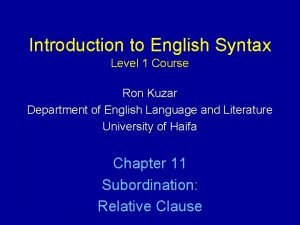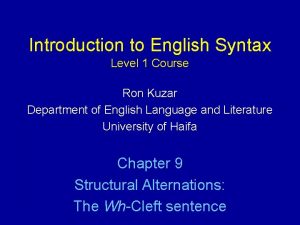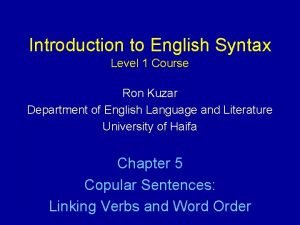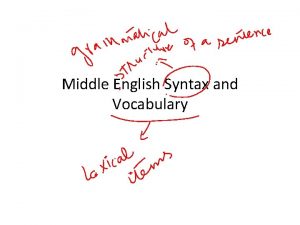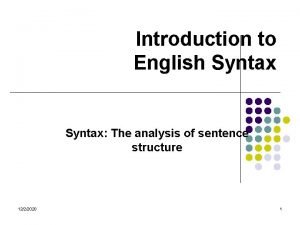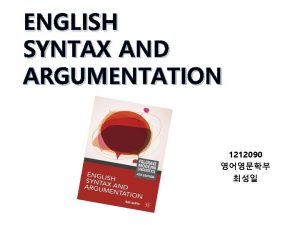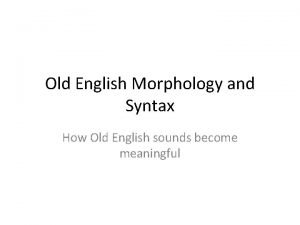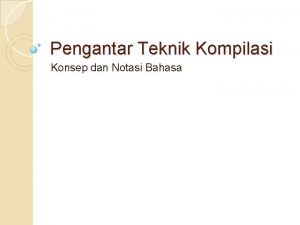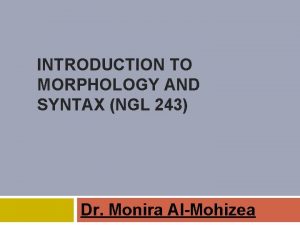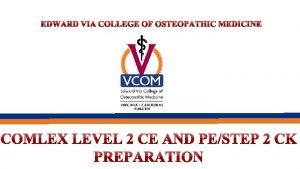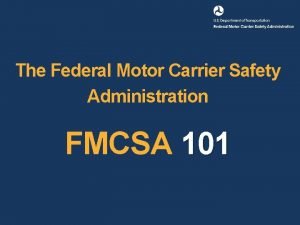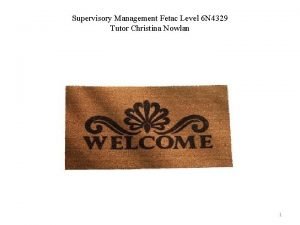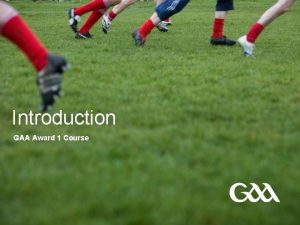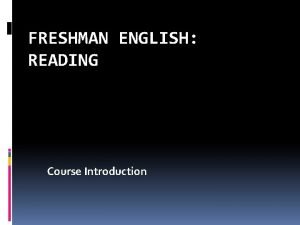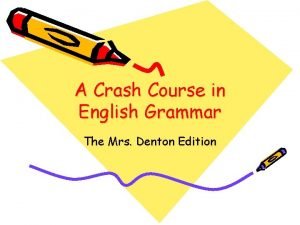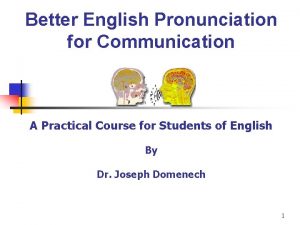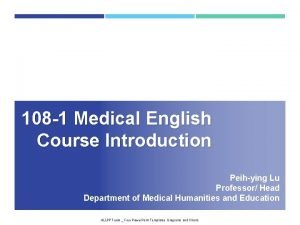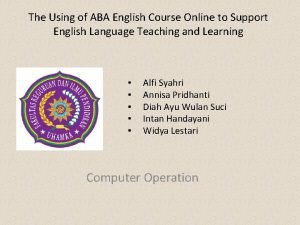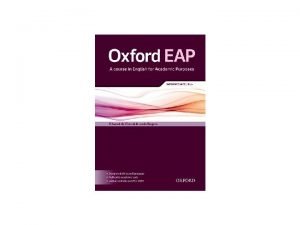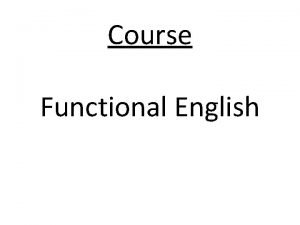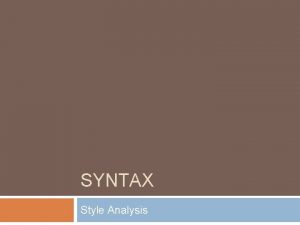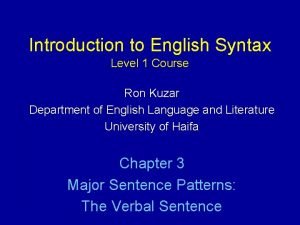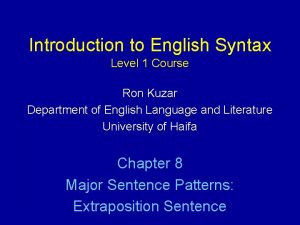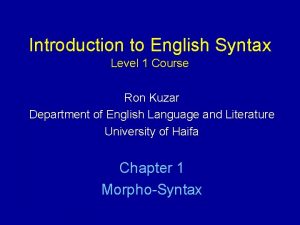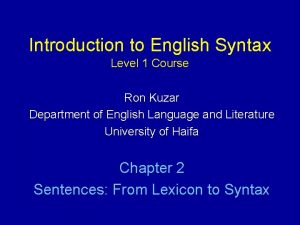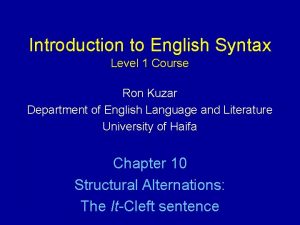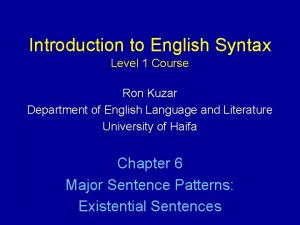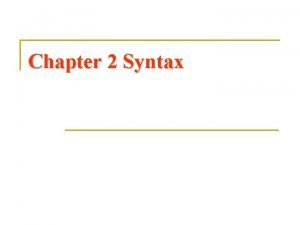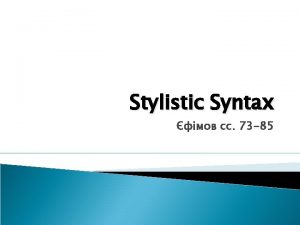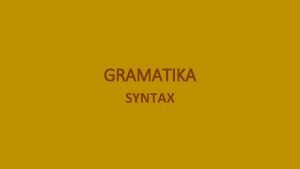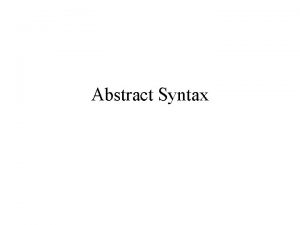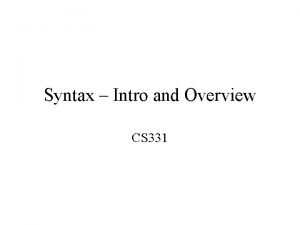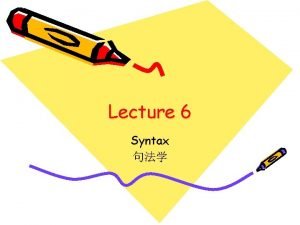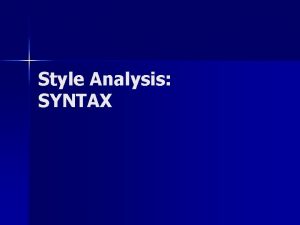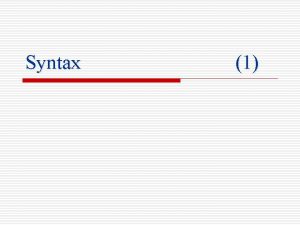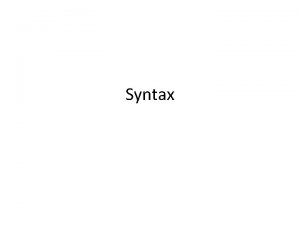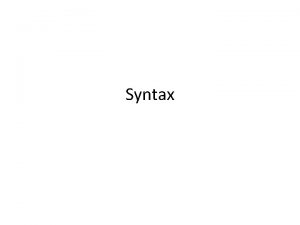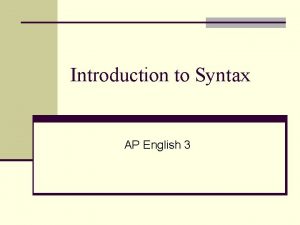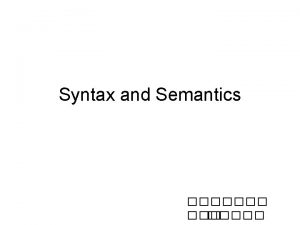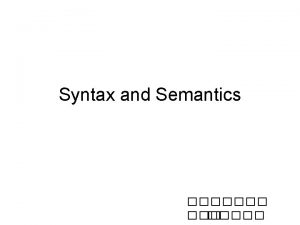Introduction to English Syntax Level 1 Course Ron



























- Slides: 27

Introduction to English Syntax Level 1 Course Ron Kuzar Department of English Language and Literature University of Haifa Chapter 11 Subordination: Relative Clause

A Sentence within a Sentence • The following sentences contain a sentence in them: – The Minister, who is the chairman of the Committee against Violence, will raise the issue of security in football stadiums during the upcoming committee meeting. – What does the thought that we may be forgotten in eternity do to us? • A sentence within a sentence is a clause, more specifically – a subordinate clause. • The containing sentence is the matrix clause.

Terminological note • Subordinate clause • Also: – Embedded clause/sentence. • Matrix clause • Also – Main clause

Types of Clauses • There are 3 types of subordinate clauses: – Relative clause – Content clause – Situation clause • This chapter is devoted to the relative clause (RC). • The next chapter will discuss the other two types.

Antecedent • Antecedent = the noun to which the RC is attached. – The Minister, who is the chairman of the Committee against Violence, will raise… • The RC is part of the NP in which the antecedent is the head. • It is an attribute of the head (=its antecedent) just like an adjective (the responsible minister). • Adjectives are simple attributes. RCs are complex attributes.

Terminological Note • Antecedent (of a RC) • Also – Head word

Subj of RC =/≠ Antecedent • The subj. of the RC = the antecedent: – The university sued the student who [subj. ] sent the defamatory letter. • The subj. of the RC ≠ the antecedent: – The president fired the worker to whom [not subj. ] the floor manager [subj. ] sent a warning letter.

Subj. of RC ≠ Antecedent: Formal Forms • There are formal and informal forms: • In the formal forms: 1. Preposition precedes the Wh-word. 2. Wh-word is in the accusative case. – The salesperson, to whom I talked. (animate) – The house at which I looked. (inanimate)

Subj. of RC ≠ Antecedent: Informal Forms • In the informal forms: • When the subj. of the RC ≠ the antecedent: 1. Preposition stranded at the end. 2. Wh-word is in the nominative case. 3. Wh-word may be replaced by that or ø. – The person who/that/ø I talked to. (animate) – The house which/that/ø I looked at. (Inanimate)

Possessive RC • with Animate Antecedent: – The customer, whose name I don’t remember, left an hour ago. • With inanimate antecedent: – The book, whose name I do not remember, has been returned. • OR – The book, the name of which I do not remember, has been returned.

Pied-Piping • The part before of which may be long: – The book, the very strange name of which I do not remember, has been returned. • This phenomenon is called pied-piping. • The word which drags with it the whole noun phrase.

The Pied-Piper of Hamelin

Restrictive RC • When the RC selects (=restricts) the antecedent as a particular member out of its group, it is a restrictive RC. • In that case, who/which, ø, or that may be used: – The workers who/that went on strike were fired. [There must have been other workers that didn’t strike. ] – The picture which/that/ø I loved was not for sale. • [As opposed to other pictures. ] • A restrictive RC is usually uttered without pauses. In writing, no commas are used.

Descriptive RC • When the RC provides a description of the antecedent without selecting it out of its group, it is a descriptive RC. • In that case, who/which may be used, but not that or ø: – The workers, who went on strike, were fired. [This may refer to ALL the workers. ] – The picture, which I loved, was not for sale. [This could have been the only picture. ] • A descriptive RC is usually uttered with pauses around it. In writing, commas are used.

Terminological Note • Descriptive RC • Also – non-restrictive RC

Postponed RC • Consider the following sentences: – A camera-man came up. – A truck drove by. • Note that such sentences typically have an indefinite subject and an intransitive (presentative) verb. • Here they are again with descriptive RCs: – A camera-man, who wanted to check out the scene, came up. – A truck, whose driver was humming country music, drove by.

Weight Considerations • Note that the relative clause is longer, i. e. “heavier”, than the presentative VP. • In English, heavy parts of the sentence are sometimes preferred at the end. • Here, the heavy RC is not inside its NP, but rather at the end of the sentence, beyond the relatively light VP: – A camera-man came up, who wanted to check out the scene. – A truck drove by, whose driver was humming country music.

Terminological Note • Postponed RC • Also – Extraposed RC

Sample Question • For each sentence do the following: – Identify the relevant NP. – Identify the antecedent and determine if it is or is not the subject of the relative clause. – Where applicable, determine if the RC is in formal or informal style. – If the RC is possessive, check if pied-piping occurred. – Identify the RC as restrictive or descriptive. – Identify postponed RCs in presentative sentences. – Note: some sentences have more than one RC.

Sample Question (continued) – He used the only tool he possessed, which was a wrench. – The captain, who was sitting at his regular table, nodded to himself again and again. – I’ve implemented a kind of tagging system, the details of which would be too involved to describe here. – Don’t tell me you have never seen the photo that I showed you yesterday. – Only another planet, whose orbit lay beyond the known ones, could explain the behavior of the nearer planets.

Sample Question (continued) – The ticket which I purchased from ISSTA was cheaper than John’s. – Her request, which he paid no attention to, went unanswered. – He had to apologize for his behavior, for which he had no explanation. – In the next stretcher, a radiology patient arrived, who required acute interventions.

Answers – NP: the only tool he possessed, which was a wrench. Antecedent: tool. RC 1: he possessed. Antecedent ≠ SUBJ. Restrictive. RC 2: which was a wrench. Antecedent = SUBJ. Descriptive. – NP: The captain, who was sitting at his regular table, Antecedent: captain. Antecedent = SUBJ. descriptive.

– NP: a kind of tagging system, the details of which would be too involved to describe here. Antecedent: system. Possessive. Pied-Piped: The details of which. Descriptive. – NP: the photo that I showed you yesterday. Antecedent: photo. Antecedent ≠ SUBJ. Restrictive. – NP: Only another planet, whose orbit lay beyond the known ones, Antecedent: planet. Possessive. Descriptive.

– NP: a radiology patient, who required acute interventions. Antecedent: patient. Antecedent = SUBJ. Descriptive. Postponed RC. – NP: The ticket which I purchased from ISSTA Antecedent: ticket. Antecedent ≠ SUBJ. Restrictive. – NP: Her request, which he paid no attention to, Antecedent: request. Antecedent ≠ SUBJ. Descriptive. Informal.

– NP: his behavior, for which he had no explanation. Antecedent: behavior. Antecedent ≠ SUBJ. Descriptive. Formal.

Homework – We met the lady whose son works in the library. – Then suddenly a scream was heard, which curdled our blood. – They brought up an idea I couldn’t agree with. – This is a major disaster, the exact reasons for which I cannot discern. – I don’t want to touch food I don’t know, which may make me sick. – The disc which you have mentioned arrived today. – The prime minister, who seemed to be in a grave mood, refused to answer any questions.

– I remember an anecdote the source of which I forget. – Putting a preposition at the end of the sentence is something I cannot put up with.
 Ron had a course introduction
Ron had a course introduction Simplex sentence
Simplex sentence Awe aldermaston
Awe aldermaston Syntax directed translation scheme
Syntax directed translation scheme Middle english words
Middle english words English syntax analyzer
English syntax analyzer English syntax and argumentation
English syntax and argumentation Early modern english syntax
Early modern english syntax Old english morphology
Old english morphology Sailor course brick
Sailor course brick Course title and course number
Course title and course number Course interne moyenne externe
Course interne moyenne externe Introduction syntax
Introduction syntax Simple and complex words examples
Simple and complex words examples Comlex level 2 prep class
Comlex level 2 prep class Dayone dayone noodles ss2
Dayone dayone noodles ss2 Fmcsa north american standard level i course online
Fmcsa north american standard level i course online Fetac levels chart
Fetac levels chart Gaa level 1 coaching course
Gaa level 1 coaching course Freshman english 1
Freshman english 1 Crash course english grammar
Crash course english grammar A practical course in english pronunciation
A practical course in english pronunciation Learning english course
Learning english course Medical english online course
Medical english online course Aba english course
Aba english course Short authentic academic text
Short authentic academic text Functional english course outline
Functional english course outline What is esp english for specific purposes
What is esp english for specific purposes
